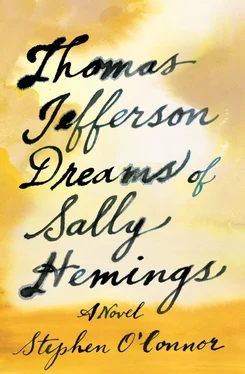“It’s vivid, all right. And clear. Maybe too clear. But at the same time there’s no meaning there. And nothing makes any sense. Really it’s more like a hallucination.”
“Fuck you!” She flings her thighbone at me. “You’re the hallucination!”
Thomas Jefferson grabs her forearm. “Sally!”
“Go on — get out of here!” She makes a scat motion at me with her free arm and hand.
“Sally!” says Thomas Jefferson. “He’s delusional. He hasn’t eaten in days.”
“Fuck you, too!” she says. Then swings her foot in a wide arc around his legs and kicks me in the shin.
“Go on!” she says. “Beat it! Scram! Begone!”
Reading lessons are no longer possible. The only way that Thomas Jefferson and Sally Hemings can manage being together when anyone else is around is by studiously avoiding each other’s gazes and exchanging only the most commonplace remarks. And when they are alone, reading is something less than a top priority. She shows Jimmy the primer that Thomas Jefferson bought and asks if he will at least help her memorize the sounds of the letters, and he just shakes his head and looks away. “Seems to me,” he says in a low voice, “that you got too many other things to worry about to bother with reading.” When she asks him what he means, he says, “Nothing at all. You just seem like you got a lot on your mind.” She decides not to pursue the conversation any further.
Sunday morning, shortly before lunch, Patsy is on the window seat, frowning into a slim pamphlet that she clutches with both hands. Sally Hemings is sitting on a small chair nearby, embroidering one of Polly’s pillowcases with a scene of Monticello: Three wide, upside-down green V’s representing the Blue Ridge Mountains. A dozen horizontal yellow rows representing August wheat. And to the right a burgundy square with white columns and a low white roof: the great house. She glances at Patsy again and again, and when she catches the girl’s eye, she smiles and asks, “What are you reading?”
Patsy lowers the pamphlet to her lap. “Abbé Sieyès,” she says.
“Is it good?”
“It’s supposed to be.” Patsy sighs. “But I think every one of his ideas was stolen from Papa.”
“Why did he do that?” says Sally.
“Because Papa is a brilliant man. His ideas have changed the world. And Abbé Sieyès wants to be the Thomas Jefferson of France.”
Sally Hemings becomes thoughtful for a moment. Then she says, “I wish I could read.”
“You should learn.”
“But there is no one to teach me.”
There is an odd expression on Patsy’s face: irritation competing with some gentler emotion. Finally she says, “I can teach you.” She pats the upholstered bench beside her. “Come here.”
As Sally Hemings puts her embroidery into a silk-lined basket, Patsy squints at the pamphlet in her hands. She closes it and places it on the seat beside her. “It is better if you learn to read English,” she says. “Bring me that book over there.” She points to a row of some dozen books atop the mantelpiece.
“Which one?” says Sally Hemings.
“That one,” says Patsy. “On the end.”
Sally Hemings pulls the indicated book off the mantelpiece and goes to sit next to Patsy. The two girls’ eyes are exactly the same shape, though Patsy’s are chestnut brown. The girls also have the same high cheekbones and long jaw, though Patsy’s jaw is fuller—“more feminine,” is how she describes it; she thinks of Sally Hemings’s face as “pointy.”
“This book is by Papa.” Patsy opens the book and points to two words in squarish lettering on the first printed page. “Thomas,” she says, and, “Jefferson.” Sally Hemings thinks she probably could have figured out what those two words were, but she is not sure whether that would have qualified as reading. Then Polly runs her finger slowly under the six large words on the top half of the page, saying, “Notes… on… the… State… of… Virginia.” She takes Sally Hemings’s hand, grasps her index finger and puts it under the first word. Once Sally Hemings has successfully copied the motion of Patsy’s hand and repeated the words she has just heard, Patsy says, “Very good. You can read!”
Sally Hemings smiles in a way that she hopes hides her irritation. “Tell me the sounds of the letters,” she says.
Patsy complies but has only gotten through “Notes” when Thomas Jefferson appears in the doorway and says, “Dinner, my dear!”
Patsy eagerly closes the book and puts it on top of the pamphlet by Abbé Sieyès. She hurries over to her father and kisses his cheek. “Greetings, Pa- pah !”
Thomas Jefferson looks across the room at Sally Hemings with an expression that seems equally likely to become a smile or a contortion of grief.
Sally Hemings can hardly bear to look at him, but she also can’t look away. She is standing, but her legs are suddenly so restless she has to fight to keep still.
“What have you been doing?” he asks his daughter absently.
“I’ve been teaching Sally to read. We’re starting with your book!”
Thomas Jefferson laughs in surprise. His expression has become a broad, happy smile, but he is looking at Sally Hemings with such fierce longing that she has to sit back down.
Patsy’s eyes move from the very strange expression on her father’s face to the dazed, almost frightened expression on Sally Hemings’s, then back again. She does this several times.
“That’s wonderful,” says Thomas Jefferson. He puts his arm around his daughter’s shoulders, steers her out of the room and, over the top of her head, gives Sally Hemings one last, lingering glance.
Patsy also casts one last glance over her shoulder, her expression rendering confusion on the verge of becoming a threat.
Whether the black of the Negro resides in the reticular membrane between the skin and scarf-skin, or in the scarf-skin itself; whether it proceeds from the colour of the blood, the colour of the bile, or from that of some other secretion, the difference is fixed in nature, and is as real as if its seat and cause were better known to us. And is this difference of no importance? Is it not the foundation of a greater or less share of beauty in the two races? Are not the fine mixtures of red and white, the expressions of every passion by greater or less suffusions of colour in the one, preferable to that eternal monotony, which reigns in the countenances, that immoveable veil of black which covers all the emotions of the other race? Add to these, flowing hair, a more elegant symmetry of form, their own judgment in favour of the whites, declared by their preference of them, as uniformly as is the preference of the Oranootan for the black women over those of his own species.
— Thomas Jefferson
Notes on the State of Virginia
Written in 1781–82, published in 1787
Afterward he looks at her and smiles. She smiles, too, though there is a dart of uncertainty over one eye. “This isn’t real,” he says. He looks sad for a moment. Then he kisses her.
It is June 27, 1789, almost a month since Sally Hemings returned from Madame Gautier’s. She is kneeling on a towel in the garden, pulling Virginia carrots for Jimmy, when she notices Thomas Jefferson standing in the window of his study. The reflection of the sunlit building on the far side of the garden is across his face, so she does not see that he is looking at her until he pushes the window open and gestures for her to come.
Her whole body flushes, and she looks around to see if anyone might be watching. Deciding she has picked enough carrots to make leaving the garden seem natural, she nods once at Thomas Jefferson, stands, shakes the earth off her towel and folds it atop the carrots in her basket. Her hand rises involuntarily to tuck a loose hank of hair under her bonnet, and she also glances at the skirt of her gown to be sure no mud clings to it. She could walk down the path between the cabbage and the ankle-high corn straight into Thomas Jefferson’s study — its windows being “French windows”—but she is worried that Clotilde or, worse, Jimmy might step out of the kitchen at exactly the wrong moment. So instead she walks toward the kitchen door. Just as she is about to enter, she sees Thomas Jefferson pull the windows to his study shut.
Читать дальше












